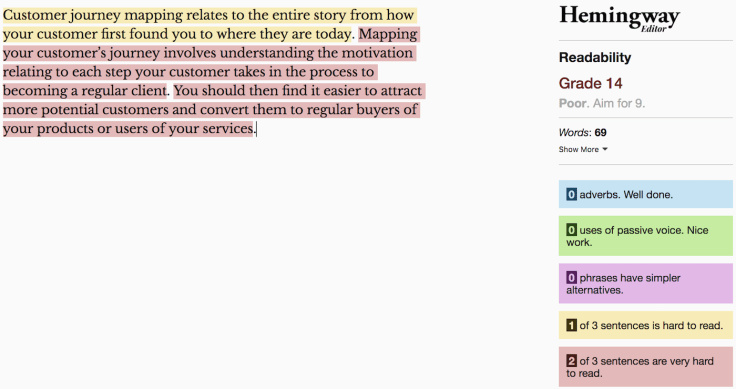

Some time ago, we decided that it’s time to start to accept guest post contributions.
It sounded like the best idea ever!
Through the eyes of imagination, I saw our blog flooded with great posts all these great content writers would send us! I saw tons of valuable content enriching our blog, happy readers benefiting from the knowledge we share, what could possibly go wrong?
Now, after a year and a half of dealing with freelance bloggers and content writers, I see how naive I was. I thought that guest posting would become a perpetual motion. Instead, it turned to be a pain in a butt that triggered the instinct of a killer in me.
Luckily, one of the great homo sapiens’ features is the ability to learn from misfortunes.
Even though I spent a lot of frustrating hours over horrible pieces of content, recently, I realized that it helped me to understand what great writing is! By understanding what makes content bad, I was able to avoid these mistakes in my own writing. In the end, it made me a better content writer.
Here’s what I learned.
But first…
How we do it - contributor’s guide
In a perfect world, a content writer decides to publish a post on our blog, because they know it, like it, and they think that their post would fit it.
Before they come out with an idea of a post, they carefully read our contributor’s guide to learn what are we looking for. Since they know we write about ecommerce and customer service, they choose three nice topics and send it to us with brief outlines so we can choose one of them.
A draft that we receive, is great.
First of all, it’s written in simple language so everyone can understand the idea behind it. Secondly, it describes the idea in depth and explains difficult points with real-life examples. Another great thing is that an author refers to their own experience and their personality speaks through their words, making it even more fun to read.
The process of publishing is a pleasure to me and I’m honored to read such great stuff!
And what does it look like in real life?
I could describe my feelings this way:

Most people have no idea we have contributor’s guides. Even when they do, they don’t read it. Or at least, they have a problem adapting their drafts to our requirements. They send posts filled with clichés, grammar errors, style mistakes, lack of originality and a lot of idea copy-pasting.
But some people go even further!
Here’s a screenshot of an email we’ve received lately:

This email was sent to 16 email addresses (including ours). And the best part of it was that one of these recipients actually responded to this email, replying to all:

I think this email perfectly describes the level frustration when dealing with such submissions, but such formal things are nothing when compared to the quality of content you have to go through.
Here are mistakes I see all the time in drafts we receive.
Mistake #1: “7 secrets” and “10 tips to”
The easiest post you can imagine is the “top” kind of posts.
Why it’s so simple? Because you don’t have to be an expert to write one. Actually, you don’t even have to know anything about the topic, because Google!
So, let’s say I get a topic idea and it’s “7 Tips on How to Turn Your Content Marketing into Money-Making Machine.” Sounds tempting, right? Show me a content writer who wouldn’t like to read that!
But when I start reading, I can see that it doesn’t look good.
Apart from the statement that “content is king” that’s repeated at least twice (grrrr!), I would probably get these wonderful pieces of advice:
- Know your audience,
- Create great content,
- Add value,
- Use the right voice,
- Make your content readable,
- Know your goals,
- Don’t be too salesy.
As you might guess, the author won’t get into details here, they will rather elaborate on why it’s important to know your audience or why great content is better than the bad one.
What I learned from that:
I think now that the most valuable posts are those that focus on one topic and cover it in depth. Now, I’m nuts about actionable steps and real-life examples. Instead of reading why “adding value” is so important for readers, I’d rather see a step-by-step guide on how to optimize my post for SEO.
Also, I will never make this mistake when trying to publish my post on a different blog.
Mistake #2: Difficult language
One of the most common mistakes I see in articles is that they are very difficult to read.
Any person that had the occasion to read one of our posts probably knows that we aim to write clearly and simply. Sometimes we explain quite difficult concepts and simplicity of language helps our readers to better understand it.
Unfortunately, some of our guest writers write complex, difficult sentences making the reading equally pleasant to reading random Wikipedia pages.

What I learned from that:
Let me just quote the famous jazz musician, Charles Mingus:
Anyone can make the simple complicated,Creativity is making the complicated simple.
Mistake #3: Juggling with numbers without getting to the point
We all love numbers and statistics. Numbers also make the impression that you’ve made a lot of research while writing. Your article looks much smarter with it and because people love numbers, it’s hard to reject post filled with them, right?
Wrong!
Recently, one of our guest writers sent me a draft of “How to Use LinkedIn to Boost Your Sales.” We like retail-related topics, so it looked like a great fit for blog.
I have to admit that when I started to read it, I was happy with it. The post looked well-researched (you guessed right, it contained a lot of interesting statistics) and I was looking forward to learning how LinkedIn can boost sales.
Instead, I had numbers. How many people use LinkedIn daily, how many of them use it monthly. How many brands have their profiles there and how many of them markets their services on LinkedIn. There was even information about how much can LinkedIn boost your sales, but there was no information how to do it!
What I learned from that:
Numbers are great and I encourage to add them to your post, however, the most important thing is the promise from your title.
If you’ve promised that you’ll teach me how to make money on LinkedIn, I should be able to implement your strategy as soon as I finish reading your post. If you don’t know how to teach me that, a “statistics smoke screen” won’t help you.

Mistake #4: Underestimations of subheaders
To be honest, I never thought that a person that writes for living can underestimate the importance of subheaders. But it turns out that many content writers are guilty of this sin!
Imagine how surprised I was when I saw for the first time a subheader “And Then I Said to Myself…”! It turned out that it wasn’t a “content marketing donkey”: a lot of writers make this mistake!
What I learned from that:
Subheaders like H2 and H3 do make the article look much nicer, but there’s more than that! Subheaders help to structure the entire page, make reading and skimming much easier and play an important role in search engine optimization.
I’m not telling that every subheader should contain a keyword, but for heaven’s sake, at least let’s make it meaningful.
<h2< mistake="" #5:="" a="" not="" so="" happy="" ending="" <="" h2="">
One of the most irritating things in reading guest posts is when I see the conclusion of the post and it’s called “Conclusion.” Sometimes, when the author decides to be "creative", they call it “Final words” or “Last words.”
It's lazy!
I immediately imagine such author finishing the post as soon as possible, to finish this dreadful task. I can almost hear them thinking: “It takes too much of my time to come out with a decent title, let’s have the “conclusion,” it’s always a great choice.”
As you can guess, such conclusions are in most cases two or three sentences long and the whole post would benefit if they just skipped the whole paragraph.
I can remember that one day I was so frustrated that I added to our guide that we don’t accept calling conclusion a “Conclusion.” As you can guess, it didn’t change anything.
What I learned from that:
When someone is dealing with guest posts on a regular basis, they can immediately tell how much time you’ve spent on writing and how much heart you’ve put into that. If you are not able to spend a minute to think up a better header, it means that probably the whole post sucks.

The principles of craft
After a year and a half of dealing with guest posts, I learned a lot about writing. Being in frustrating touch with bad writing made me realize that it’s actually quite easy to write good stuff.
The most important thing is to do your research. Lazy writers write lazy posts like “10 secrets of,” because writing a couple of general sentences is much easier than covering one topic in depth.
Make sure you write clearly and use quite simple vocabulary. Think about the person that’s going to read it, you don’t want to torture your readers, right? Instead of using complicated sentences and jargon, impress people with your knowledge.
Don’t under- or overestimate SEO, but keep it in mind that your writing should be easily found by your readers. SEO can help with that.
Make sure that your post’s ending doesn’t look like you were desperately wanting to finish it as soon as possible. Avoid using “conclusion” as a title of your conclusion, and don’t write “last words” when you’re writing your last words.
I'm sure that above pieces of advice will help you to become better content writers. In exchange, I'd appreciate if some of you could share a good strategy for dealing with poorly written guest posts and not getting frustrated ;)
</h2<>



